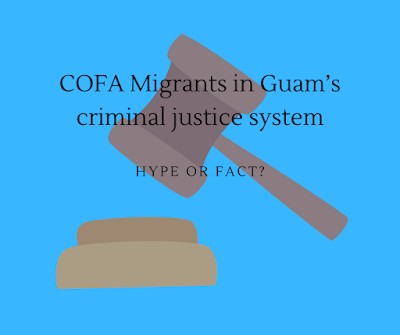As someone who has closely followed and written about the portrayal of the Micronesian community in Guam, particularly the negative media coverage surrounding Micronesians in the courts, I approach the latest developments shared in a recent article entitled: Advisory group to tackle 'overrepresentation of COFA migrants in Guam's criminal justice system' with a critical lens.
Recently, the Guam Advisory Committee to the bipartisan U.S. Commission on Civil Rights convened to address a sensitive question: Is there an overrepresentation of Compact of Free Association (COFA) migrants in Guam's criminal justice system? This question stems from public perception, heavily influenced by years of negative media portrayals of Micronesians, especially Chuukese, as a group prone to crime and conflict. But is this perception backed by facts?
According to committee Chairperson Vanessa Williams, the issue is far more complex than public narratives suggest. The committee, made up of legal experts, scholars, and community advocates, is examining the data and context behind this alleged overrepresentation. And here’s where things get interesting—the data presented at the Aug. 14 virtual briefing suggests that the majority of individuals in Guam's criminal justice system are not COFA migrants, despite what the public might believe.
So, if the numbers don’t point to Micronesians dominating the criminal justice system, why does the stigma persist? As a Devil's Advocate, I would argue that this is a clear example of how negative media coverage perpetuates harmful stereotypes. I can still remember reading news stories after news stories portraying Micronesians as criminals from the Guam media. They were having a field day portraying Micronesians as lawbreakers and criminals. And the comments from the population in Guam, mostly immigrants, were as negative as it gets.
The panelists in the briefing, including experts like Josie Howard and Ansito Walter, emphasized the need for cultural sensitivity, both in and out of the justice system. They highlighted how cultural differences, particularly the communal nature of Chuukese society, clash with Guam’s individualistic, capitalistic norms. It’s no wonder that this clash leads to misunderstandings, not just in the justice system but in everyday interactions that get sensationalized by the media.
The public’s perception of Micronesians as being overrepresented in the criminal justice system might stem from these cultural misunderstandings, exacerbated by the media's focus on isolated incidents involving COFA migrants. As pointed out by Williams, the reality is that stereotyping diminishes when Micronesians engage more deeply in Guam’s government and civil sectors—former Sen. Clynt Ridgell being a prime example.
Yet, even with these efforts, public bias remains entrenched. The question then becomes, how much of this so-called overrepresentation is a product of skewed media narratives versus genuine systemic issues? While there may be cases where Micronesians face difficulties with the law, the media's negative portrayal fuels a one-dimensional narrative that paints the entire community in a bad light. This leads to heightened scrutiny, reinforcing the public's unfounded fears and biases.
As the Guam Advisory Committee continues to investigate and compile its report, one must ask whether this focus on overrepresentation might be part of the problem rather than a solution. By continuously questioning whether Micronesians are overrepresented in criminal statistics, are we not, in fact, reinforcing the very stereotypes we seek to dismantle? Perhaps the real issue lies in how the justice system and media treat Micronesians—not as inherently criminal, but as individuals caught in a complex web of cultural differences, systemic biases, and deeply ingrained prejudices.
The next step will be crucial. As the U.S. Commission on Civil Rights reviews the report, one hopes they will take a more nuanced approach. Instead of focusing solely on overrepresentation, the emphasis should be on improving cultural sensitivity, ensuring fair treatment, and holding the media accountable for the role it plays in shaping public opinion.
Ultimately, the narrative that Micronesians are overrepresented in Guam's criminal justice system may be overblown, driven more by perception than reality. The challenge is to change this narrative by addressing the root causes—cultural misunderstandings, media bias, and systemic inequities—so that all residents of Guam, regardless of background, receive fair and equal treatment under the law.
---------------------------------------------------------------------------------------------------------------------
Hey everyone! If you love the vibrant culture and beautiful designs of Micronesia, check out the amazing Micronesian Merch available through the affiliate links in the description below. By using these links, you not only get to own some Micronesian merch but also support our blog. Happy shopping, and thanks for your support!
Heart and Soul belongs in Micronesia Tee
Please note that some of the links in this description are affiliate links, which means that if you purchase through them, I may earn a small commission at no extra cost to you. This helps support the channel and allows me to continue creating content for you. Thank you for your support!




0 Comments